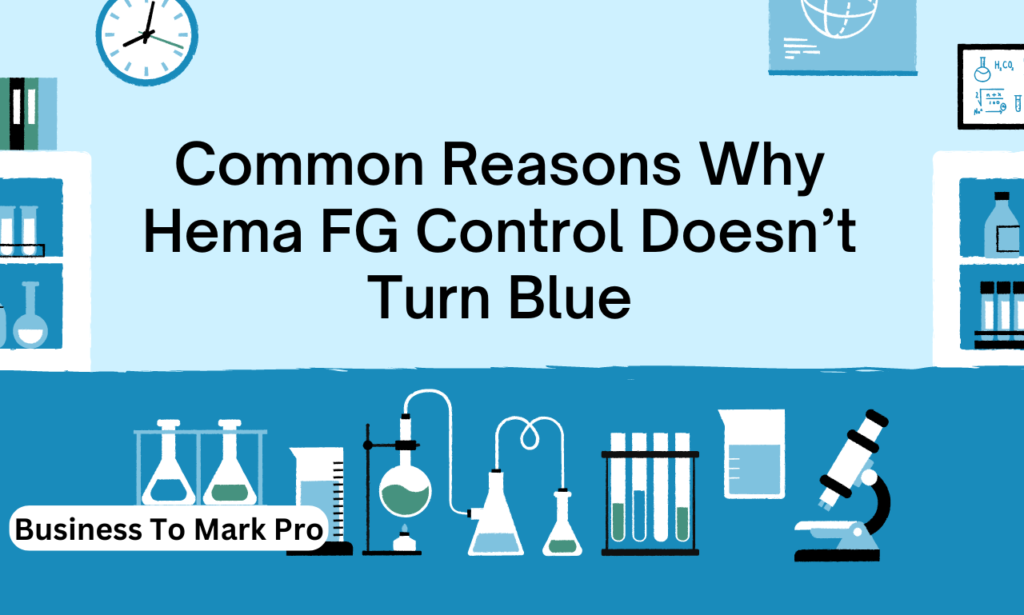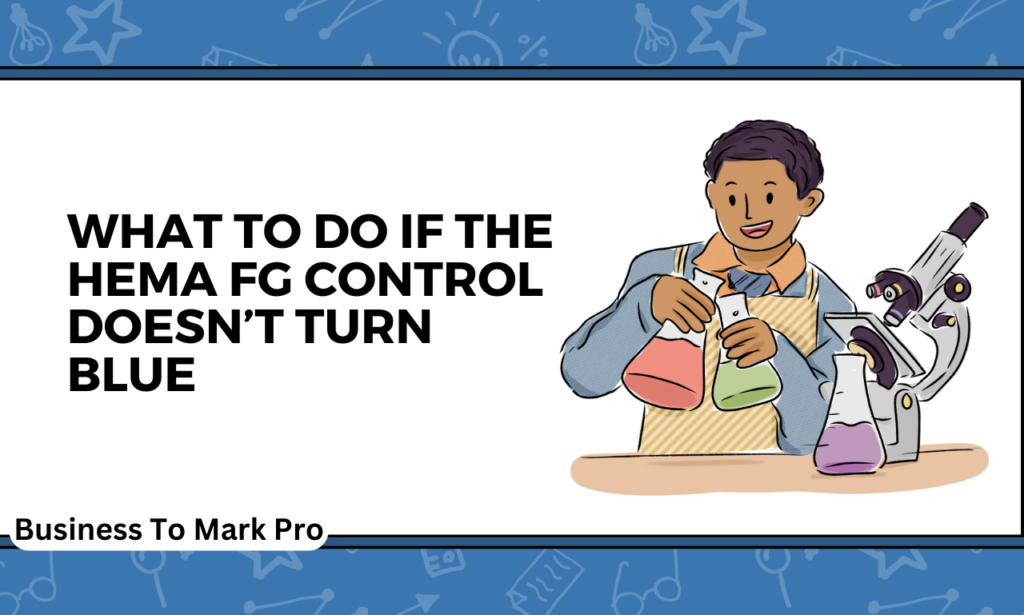Have you ever wondered why the Hema FG control in your test kit doesn’t turn blue? It can be frustrating and puzzling, especially if you’re relying on accurate results for something important. If you’ve faced this problem, you’re not alone. Many people encounter this issue, and it can be a sign that something is not quite right. But don’t worry! In this article, we’ll break down everything you need to know, from why it happens to how you can troubleshoot the problem effectively.
Let’s dive into what could be happening, the role of the Hema FG control, and how you can ensure that your results are reliable.
- Understanding the Hema FG Control
- Why Does the Hema FG Control Turn Blue?
- Common Reasons Why Hema FG Control Doesn’t Turn Blue
- What to Do If the Hema FG Control Doesn’t Turn Blue
- Preventing Issues with Hema FG Control
- The Importance of Reliable Testing
- Conclusion: What Now?
- FAQs About If Hema FG Control Doesn’t Turn Blue: What It Means and What to Do
Understanding the Hema FG Control
Before we get into why the Hema FG control doesn’t turn blue, let’s start by understanding what the Hema FG control is and why it’s important. The Hema FG control is a critical component used in certain diagnostic tests, often related to blood or other biological samples. The purpose of this control is to serve as a reference to ensure that the test results are accurate. When working correctly, the control should change color—typically turning blue—to indicate that the test has been performed properly.
Why Does the Hema FG Control Turn Blue?
The blue color change happens because of a chemical reaction between the control and the testing reagents. This reaction is a visual confirmation that the test kit is functioning as intended. If the control doesn’t turn blue, this could be a sign that something went wrong in the testing process, or that the reagents themselves are not functioning properly.
Common Reasons Why Hema FG Control Doesn’t Turn Blue

Now that you know what the control is supposed to do, let’s explore the reasons why it may fail to turn blue. Several factors could be at play, ranging from issues with the test kit to external environmental conditions. Below are the most common causes:
1. Expired or Faulty Reagents
One of the leading causes for the Hema FG control not turning blue is the use of expired or faulty reagents. Over time, the chemicals in the reagents may degrade, which affects their ability to produce the necessary reaction. Always check the expiration date of your test kit, and if the reagents are expired, dispose of them and use a fresh kit.
2. Incorrect Storage Conditions
If the reagents or the control have not been stored properly, this can also prevent the control from turning blue. Most kits require storage in a cool, dry environment. Exposure to heat, moisture, or direct sunlight can degrade the effectiveness of the chemicals. Always follow the manufacturer’s storage recommendations to ensure accurate results.
3. Improper Test Procedure
Another possibility is that the test procedure wasn’t followed correctly. The Hema FG control relies on precise steps being taken in the right order. Missing a step or not mixing the reagents properly can prevent the control from working as it should. Double-check the instructions to make sure that every step is being performed correctly.
4. Contaminated Samples
If the sample being tested is contaminated, this can interfere with the chemical reaction between the control and the reagent. Contamination can come from a variety of sources, such as improper handling of the sample or using equipment that hasn’t been sterilized. Make sure that you’re following all necessary precautions to prevent contamination.
5. Reagent Deterioration Due to Age
While expiration dates give a general idea of reagent lifespan, reagents can sometimes deteriorate even before they expire. Environmental exposure or frequent temperature fluctuations can speed up this process, causing the reagent to lose its effectiveness.
What to Do If the Hema FG Control Doesn’t Turn Blue

If you find that your Hema FG control isn’t turning blue, don’t panic. There are several steps you can take to troubleshoot and resolve the issue.
1. Check the Expiration Dates
The first step is to check the expiration date on your test kit and reagents. If they are expired, you will need to replace them. Using expired chemicals will almost certainly result in inaccurate results.
2. Review the Test Instructions
Carefully go over the test instructions to make sure that you’ve followed each step correctly. Sometimes a small mistake, like not adding enough reagent or not allowing enough time for the reaction to occur, can prevent the control from turning blue.
3. Re-run the Test with a New Sample
If everything appears to be in order and the reagents are not expired, try re-running the test with a new sample. Make sure that all equipment is clean and that the sample has not been contaminated in any way.
4. Consult the Manufacturer’s Guidelines
If the control still doesn’t turn blue after trying the above steps, consult the manufacturer’s guidelines. There may be specific troubleshooting steps provided in the manual, or you can reach out to the manufacturer for technical support.
5. Replace the Test Kit
If nothing works, it’s possible that the test kit itself is faulty. In this case, you’ll need to replace the kit. Always buy test kits from reputable manufacturers and distributors to ensure the highest quality.
Also Read: Hays Kevlar Clutch and Pressure HP 5552-1: The Ultimate Upgrade
Preventing Issues with Hema FG Control
Of course, the best way to deal with issues like the control not turning blue is to prevent them from happening in the first place. Below are some tips to help you avoid common problems.
1. Store the Kit Properly
As we mentioned earlier, proper storage is crucial. Always store the kit in a cool, dry place away from direct sunlight or heat. This will help preserve the integrity of the reagents.
2. Use Fresh Kits
If possible, try to use the most up-to-date test kits available. Reagents lose their effectiveness over time, so using a fresh kit will increase the likelihood of obtaining accurate results.
3. Follow the Instructions
Make sure you read and follow the instructions provided with the test kit. This might seem obvious, but even experienced users can sometimes overlook a step. Following the procedure carefully will ensure that you get the most accurate results possible.
4. Minimize Contamination
Be diligent about preventing contamination of your samples and equipment. Always use clean, sterilized equipment and avoid touching the sample or reagents with your hands. Even a small amount of contamination can skew the results.
The Importance of Reliable Testing
When dealing with diagnostic tests, reliability is everything. Whether you’re a healthcare professional, a researcher, or someone using a home test kit, you rely on accurate results to make important decisions. The Hema FG control not turning blue might seem like a small issue, but it can have a significant impact on the outcome of your test.
Taking the necessary steps to troubleshoot and resolve this issue is crucial for ensuring that the results you get are valid and trustworthy. By understanding the potential causes and solutions, you’ll be better equipped to handle this problem if it ever arises.
Conclusion: What Now?
The next time you notice that your Hema FG control isn’t turning blue, don’t just toss the kit aside in frustration. Take a moment to consider the potential causes, from expired reagents to procedural mistakes. By following the troubleshooting steps we’ve outlined, you can get to the bottom of the problem and ensure that your test results are accurate.
And remember, proper storage and handling of your test kits will go a long way toward preventing issues from arising in the first place. So, whether you’re conducting research, diagnosing a condition, or just satisfying your curiosity, the right approach to using Hema FG controls will help you get the results you need—hopefully, with that reassuring blue hue.
FAQs About If Hema FG Control Doesn’t Turn Blue: What It Means and What to Do
1. Why doesn’t the Hema FG control turn blue during my test?
The Hema FG control may fail to turn blue for several reasons, including expired or faulty reagents, improper storage conditions, incorrect test procedures, or sample contamination. The blue color change signifies that the test is working properly, so if it doesn’t happen, it could indicate an issue with the chemicals or process.
2. Can expired reagents cause the Hema FG control to not turn blue?
Yes, expired reagents are one of the most common reasons the Hema FG control doesn’t turn blue. As chemicals age, their effectiveness can degrade, preventing them from reacting correctly. Always check the expiration dates on your test kit reagents, and replace expired components to ensure accurate test results.
3. How can I prevent the Hema FG control from failing to turn blue?
To prevent the Hema FG control from failing, make sure to store your test kit according to the manufacturer’s recommendations—typically in a cool, dry environment. Follow the test instructions carefully, use fresh reagents, and avoid contaminating your samples. Proper storage and handling can help you avoid most issues with the control.
4. What should I do if the Hema FG control doesn’t turn blue after troubleshooting?
If the Hema FG control doesn’t turn blue after checking expiration dates, re-running the test, and ensuring proper procedure, consider replacing the entire test kit. Faulty kits can sometimes be the cause, especially if the reagents or components are damaged. Reach out to the manufacturer for support if the problem persists.
5. Is it safe to rely on test results if the Hema FG control doesn’t turn blue?
No, if the Hema FG control doesn’t turn blue, the test results may be unreliable. The control is designed to confirm the accuracy of the test by reacting with the reagents. If it doesn’t perform as expected, it’s a sign that something went wrong, and you should not rely on the results without resolving the issue.
